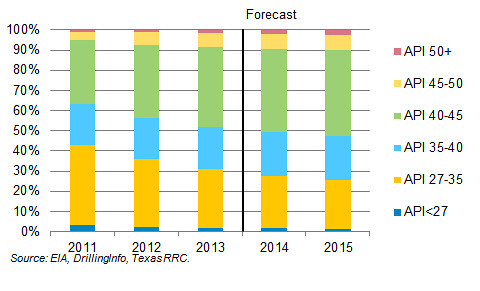Re: The Imminent Peak in US Oil Production
Plantagenet wrote:With an estimated 70 BILLION bbls of oil
Estimated by whom?
The same folks who just said "nevermind" on the 98 billion of Monterey "oil"?
resources ≠ reserves ≠ production
Exploring Hydrocarbon Depletion
https://peakoil.com/forums/
https://peakoil.com/forums/the-imminent-peak-in-us-oil-production-t70106-40.html
Plantagenet wrote:With an estimated 70 BILLION bbls of oil
Pops wrote:Plantagenet wrote:Its highly unlikely that tight shale oil production will end in the next few years when the amount of tight shale oil in the Permian basin is so huge.
Yeah, just look at how much they are getting from the Monterey.

Pops wrote:Notice the second row graphs showing a continually increasing decline in legacy fields.
Meet the Red Queen.


..the United States. Have you heard?
Computer scientist and data whiz Randy Olson dove into the UT Energy Poll data and noticed that the American public is pretty confused about where we get out energy. I can’t say I’m surprised, but Randy highlights the need for raising energy literacy across the U.S.
And perhaps, most surprising: 60% of the oil that Americans use is produced in the U.S.
Go read Randy’s terrific blog for more detail and keep in mind that the U.S is now the world’s largest oil producer. Really.
Graeme wrote:The World’s Largest Oil Producer Is…..the United States. Have you heard?
Computer scientist and data whiz Randy Olson dove into the UT Energy Poll data and noticed that the American public is pretty confused about where we get out energy. I can’t say I’m surprised, but Randy highlights the need for raising energy literacy across the U.S.
And perhaps, most surprising: 60% of the oil that Americans use is produced in the U.S.
Go read Randy’s terrific blog for more detail and keep in mind that the U.S is now the world’s largest oil producer. Really.
scientificamerican
Graeme wrote:and keep in mind that the U.S is now the world’s largest oil producer. Really.
For those following the world oil production situation, it has been clear for some time that the only factor keeping global crude output from moving lower is the continuing increase in U.S. shale oil production, mostly from Texas and North Dakota. Needless to say, once the fabled “peak” comes oil and gasoline prices are certain to move higher, triggering a series of economic events – most of which will not be good for the global economy.
Thus the key question is just how many more months or years production of U.S. shale oil (more accurately call light tight oil) will continue to grow. Many have answers to this question ranging from the “next year or so” on out the middle or end of the next decade. Some forecasts as to time remaining until the “peak” arrives are politically tinged. No politician, business manager, or even investor wants to hear that serious economic problems affecting their lives may be only a few years away. Fortunately for these folks, there are many forecasters available to spin stories about how “technology” will enable US shale oil production to continue on into the dim future of the 2020’s – which most of us really can’t comprehend or plan for.
Independent analyses of U.S. shale oil generally come to the same conclusion that production will peak in the 2016-2017 timeframe, but as noted above see a much faster decline than does the government.
There are however, other factors that could become the primary cause of world oil production peaking in the next few years. The first is the turmoil in the Middle East. A lot of oil production in the region has dropped off line in recent years for political reasons and Iraqi production is endangered. The spread of militant Islam could eventually threaten other major producers in the region as could the Arab-Israeli standoff.
Pops wrote:Notice the second row graphs showing a continually increasing decline in legacy fields.
copious.abundance wrote:Pops wrote:Notice the second row graphs showing a continually increasing decline in legacy fields.
Notice the word "legacy." The Permian has been producing for, like, a hundred years. At this point those legacy fields have little to no bearing on what the tight oil zones can do, and thus, the Permian as a whole. It's now pushing 1.8 million barrels/day and you're worrying about some old fields that are now declining 60,000 barrels/day. Big deal.
A new well is defined as one that began producing for the first time in the previous month. Each well belongs to the new-well category for only one month.
